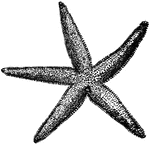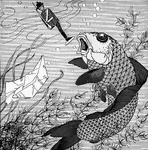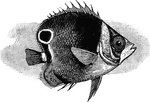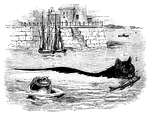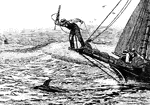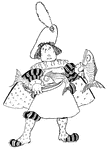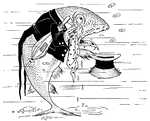Mudfish
"Ament-A kind of inflorescence consisting of unisexual apetalous flowers growing in the axils of scales…
Amphisile scutata
"The body is much compressed, and is armed with bony plates connate with the vertebrae and spinous processes.The…
Four Eyes
"There are several species of the genus, Anableps, the principal one being Four Eyes, inhabiting the…

Angelfish
"A plagiostomous fish. It is from 6 to 8 feet long, has a flat, roundish head, terminal mouth, and teerh…

Angler
"The fish Lophius piscatorius, the typical representative of the family Lophiidæ."-Whitney, 1902
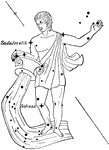
Aquarius
"A zodiacal constellation, supposed to represnt a man standing with his left hand extended upward, and…

Block and Tackle
"A Block is a pulley or a system of pulleys rotating on a pintle mounted in its frame or shell with…
!["[The paguridae] includes the Hermit or Soldier Crab, <em>Pagurus Bernardus</em>, the abdominal portion of whose body is quite soft, forming a sort of cylindrical fleshy mass behind the shelly cephalothorax. As the comfort of the animal would be materially interfered with were this soft, worm-like appendage exposed to be grabbed at by every passing fish who might take a fancy to it, he usually seeks some shelter for its tail, and the habitation selected is generally the empty shell of some univalve mollusk." — Goodrich, 1859](https://etc.usf.edu/clipart/14900/14983/hermit-crab_14983_mth.gif)
Hermit-crab
"[The paguridae] includes the Hermit or Soldier Crab, Pagurus Bernardus, the abdominal portion…

Underside of a starfish
"The organs of motion are similar, consisting of a multitude of small feet called ambulacra,…

Carp
"Carp is a fresh-water fish. It is a native of Asia, but has been extensively introduced into the United…
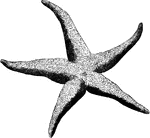
Five-fingered jack
"In this family the arms appear to be merely prolongations of the disc; they are suaully five in number,…
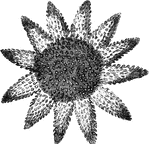
Common European sea-star
"The colors in this are variable but brilliant - red, purple, green, and white. It measures from nine…

Archerfish
"To this fish has been ascribed the power of shooting drops of water to the distance of 3 or 4 feet,…

Cephalopoda
"Cephalopoda is a class of mollusks, the highest in organization of the division of the animal kingdom.…

Giant Squid
"Giant Squid (Architeuthis dux). (From Report of U.S. Fish Commission, 1884.)-Whitney, 1902

Cemmeous Dragonet
"Dragonet is a genus of fishes remarkable for having the gill openings reduced to a small hole on each…

Drumfish
"Drumfish, or Drum, and other species of the same genus, fishes found on the Atlantic coasts of North…

Grayling
"The Grayling is a genus of fresh-water fishes in the salmon family, distinguished from trout, etc.,…
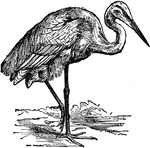
Heron
"Heron is the common name of birds of the genus Ardea. The herons are distinguished by having a long…

Common River Trout
"Trout is a term applied generally to various species of fishes belonging to the salmon family. The…

Whiting
"The fish called the whiting is met with on all the coasts of Northern Europe, and is caught in great…
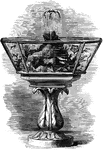
Fountain aquarium
"This is the Aquarium, consisting of a glass tank or fountain, usually of an oblong shape,…

Lumpfish
"The Lump Fish, or Sucker, is named from the clumsiness of its form. The back is arched and sharp, the…

Osprey
"The Osprey, the fish hawk, bald buzzard, or fishing eagle. A bird of prey, of almost world wide distribution…

Remora
"The Remora, the sucking-fish, or sucker. By means of the suctorial disk, a transformation of the spinous…
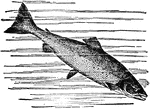
Salmon
"The Salmon is a well-known fish, inhabiting both salt and fresh waters, and ranking prominent among…
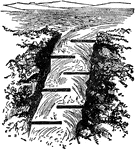
Salmon Ladder
"The Salmon is a well-known fish, inhabiting both salt and fresh waters, and ranking prominent among…

Sawfish Head
"The Sawfish is so called from the saw-like weapon into which the snout is produced. They are common…

Hooded Seal
"The Seal, of the family Phocidæ, or seal tribe, are, of all four-limbed mammiferous animals,…

Shad
"Shad is the popular name of three anadromous fishes of the genus Clupea: (1) The allice or European…
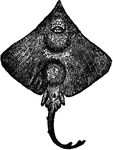
Skate
"Skate is the popular name for any individual of a section of the genus Raia, differing from the rays…

Sole
"Sole (Solea vulgaris) is a marine fish belonging to the flat fishes, of an oblong or oval form. These…
!["Starfish is a popular name for any individual of the family Asteridæ, a familiar object on the Atlantic coasts. The body is more or less star shaped, and consists of a central portion, or disk, surrounded by five or more lobes, or arms, radiating from the body and containing prolongations of the viscera. The mouth is situated in the center of the lower surface of the body, and the anus is either absent or on the upper surface. Locomotion is effected by means of peculiar tube-like processes, which are protruded from the under surface of the arms. They possess in a high degree the power of reproducing lost members and abound in all seas. [Pictured] Lesser Sand-star (Ophiura albida)"—(Charles Leonard-Stuart, 1911)](https://etc.usf.edu/clipart/16200/16266/starfish1_16266_mth.gif)
Lesser Sand-Star Starfish
"Starfish is a popular name for any individual of the family Asteridæ, a familiar object on the…
!["Starfish is a popular name for any individual of the family Asteridæ, a familiar object on the Atlantic coasts. The body is more or less star shaped, and consists of a central portion, or disk, surrounded by five or more lobes, or arms, radiating from the body and containing prolongations of the viscera. The mouth is situated in the center of the lower surface of the body, and the anus is either absent or on the upper surface. Locomotion is effected by means of peculiar tube-like processes, which are protruded from the under surface of the arms. They possess in a high degree the power of reproducing lost members and abound in all seas. [Pictured]Common Starfish, reproducing rays"—(Charles Leonard-Stuart, 1911)](https://etc.usf.edu/clipart/16200/16277/starfish2_16277_mth.gif)
Common Starfish
"Starfish is a popular name for any individual of the family Asteridæ, a familiar object on the…
!["Starfish is a popular name for any individual of the family Asteridæ, a familiar object on the Atlantic coasts. The body is more or less star shaped, and consists of a central portion, or disk, surrounded by five or more lobes, or arms, radiating from the body and containing prolongations of the viscera. The mouth is situated in the center of the lower surface of the body, and the anus is either absent or on the upper surface. Locomotion is effected by means of peculiar tube-like processes, which are protruded from the under surface of the arms. They possess in a high degree the power of reproducing lost members and abound in all seas. [Pictured]Common Starfish (Asterias rubens)"—(Charles Leonard-Stuart, 1911)](https://etc.usf.edu/clipart/16200/16278/starfish3_16278_mth.gif)
Common Starfish
"Starfish is a popular name for any individual of the family Asteridæ, a familiar object on the…
!["Starfish is a popular name for any individual of the family Asteridæ, a familiar object on the Atlantic coasts. The body is more or less star shaped, and consists of a central portion, or disk, surrounded by five or more lobes, or arms, radiating from the body and containing prolongations of the viscera. The mouth is situated in the center of the lower surface of the body, and the anus is either absent or on the upper surface. Locomotion is effected by means of peculiar tube-like processes, which are protruded from the under surface of the arms. They possess in a high degree the power of reproducing lost members and abound in all seas. [Pictured]Eyed Cribella (Cribella oculata)"—(Charles Leonard-Stuart, 1911)](https://etc.usf.edu/clipart/16200/16280/starfish4_16280_mth.gif)
Eyed Cribella Starfish
"Starfish is a popular name for any individual of the family Asteridæ, a familiar object on the…
!["Starfish is a popular name for any individual of the family Asteridæ, a familiar object on the Atlantic coasts. The body is more or less star shaped, and consists of a central portion, or disk, surrounded by five or more lobes, or arms, radiating from the body and containing prolongations of the viscera. The mouth is situated in the center of the lower surface of the body, and the anus is either absent or on the upper surface. Locomotion is effected by means of peculiar tube-like processes, which are protruded from the under surface of the arms. They possess in a high degree the power of reproducing lost members and abound in all seas. [Pictured]Gibbous Starlet (Asterina gibbosa)"—(Charles Leonard-Stuart, 1911)](https://etc.usf.edu/clipart/16200/16282/starfish5_16282_mth.gif)
Lesser Sand-star Starfish
"Starfish is a popular name for any individual of the family Asteridæ, a familiar object on the…
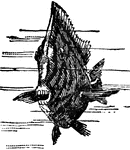
Surgeon Fish
"Surgeon-fish is a popular name for any species of the genus Acanthurus, from the sharp, erectile, lancet-shaped…

Surgeon Fish
"Surgeon-fish is a popular name for any species of the genus Acanthurus, from the sharp, erectile, lancet-shaped…
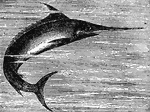
Swordfish
"Swordfish is a popular name for any individual of the Xiphiidæ. They are pelagic fishes, widely…
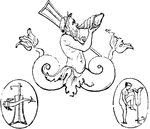
Triton
"One of the Nereides, Triton. A sea deity, son of Neptune and Amphrodite. His lower extremities were…

Pistor
"A baker, from pinsere, to pound, since corn was pounded in mortars before the invention of mills. At…





